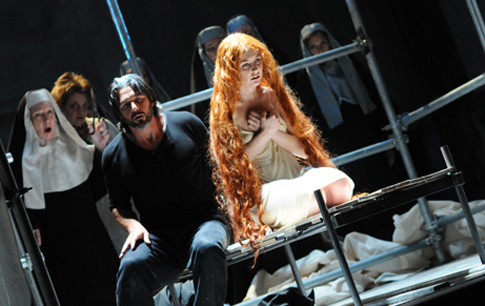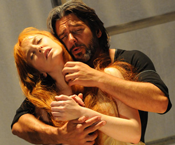Another plus: the piece is based on Pulitzer prize winner Gabriel Garcia Marquez’s compact novella of (almost) the same name. Alas, for me the promise was not completely fulfilled. To go straight to the heart(burn) of my problem with it, I found the libretto sorely lacking focus.
For in the process of reducing the emotionally complex 170-some-page story to a stage piece, librettist Kornel Hamvai (dramaturgy by Edward Kemp) lost sight of the heart of the story: the personal journey, obsession, and damnation of the young priest “Father Cayetano Delaura.” And the creators have compacted to the point of incomprehension, the rich combination of personal experiences that inform our understanding of the 12-year old child-victim “Sierva Maria,” and fail to engage our sympathies for her misunderstood erratic behavior.
The importance of the rabies scare after the girl is bitten by a mad dog, her deeply internalized immersion in two different theological worlds (one accepted, one condemned), the fatal effect of paternal neglect, the misinterpretation of pagan/folk ritual influences as “possession,” the controlling hypocrisy of the church -- all of this is compacted to the point of trivialization, giving our heroine precious little to do in Act I, save being perfunctorily committed to a nunnery-cum-asylum.
The creators seem to have been tempted to devise diversions with other secondary characters. “Don Ygnacio,” the un-engaged father, is given a long, ranting monologue which summons up shades of “Psycho” when he mournfully dons his long-dead, beloved wife’s bridal (?) dress. Tenor Robert Brubaker gave 110% to this angular, leaping vocal display, when 100% might have been better, as the tone sometimes spread or frayed.
It is easy to see why the writers would want to give “Josefa Miranda, the Mother Abbess” a disproportionate amount of stage time, since they had luxury casting of the always wonderful Felicity Palmer who typically offered firm, rich tone at all volumes, and supreme musicality even in jagged writing. But the “Abbess” arrived too early in the story, and stayed too late, upstaging the eye-popping exorcism scene of the heroine with an extended Mama-Abbess-Mad-Meltdown (no kidding) where she tears off her wimpel and veil and is backed by five non-singing, masked dancing goons straight out of the bar scene in “Star Wars.” The “Abbess”! Right, like it’s all about her? Huh?
Far better scaled, and more subtly drawn was the (truly) mad character of “Martina Laborde.” Veteran Jean Rigby was full-voiced, and compelling in her acting. Almost half of her role was spoken. While “Martina” was not drawn as the complete helpmate she was in the book, Rigby made the most of every moment and had scarily complete concentration as this nut case. Also satisfying was Marietta Simpson as “Dominga de Adviento,” the servant woman who abets “Sierva’s” immersion in the folk world. Ms. Simpson’s rich, focussed chest voice spoiled us. Her lower middle range and the softer tones in upper reaches got a bit grainy and diffuse, but never mind, as all this suited the character of the indigenous native servant.
Mats Almgren as the bishop “Don Toribio” had many powerfully booming moments, especially in the exorcism, although he also had some momentary phrases when his bass turned a tad woolly. If the agnostic doctor “Abrenuncio” was under-developed, John Graham-Hall made the most of what he was given to do.
That leaves our two principals. Remember them? I wouldn’t blame you if you lost sight of them. We did. For while their relationship unfolded slowly in the book, with great nuance and tragic inevitability, this adaptation transformed the pair’s plight into big, clumsy unmotivated chunks, with too little set-up dramatically or musically.
Nathan Gunn sang the demanding role of the tortured priest beautifully (including well modulated head voice phrases), and acted the part with abandon. After an overall restless, somewhat relentlessly twitching and declamatory Act I, suddenly Gunn was given a scena to close the act with the first real arioso singing of the night and he rewarded us handsomely. Introspective and soaring by turns, the baritone was at the top of his game. And yes, the familiar chiseled pecs were on full display as he peeled off his jacket in a sultry fantasy scene with “Sierva” above on a balcony, visually dominating him. Although the character peters out (as it were) halfway to the end after their illicit love is discovered, Mr. Gunn had made such a significant contribution to the piece that he was the most cheered singer at the call.
The talented Allison Bell had her work cut out for her as “Sierva,” challenged both by the supposed youth and dichotomy of the character, and the often ungrateful staccato shrieking she was required to execute. Indeed, two unintentional laughs came at her expense, first when her father declares her to be only 12 years old which (the nevertheless attractive and youthful) Ms. Bell clearly is not. And the other after “Sierva” has had a musical tantrum of unholy moans and high pitched yelps, to which the “Abbess” comments: “What a lovely voice.”
The soprano worked hard, very hard, and I had nothing but admiration for her pluck, her technique, the underlying sweet tone, and her willingness to do just about anything to make an effect. Still, I found the musicalization of the role to be defeating, and the unpleasant sounds that were required of her to be alienating. Maybe a wholly unique performer, say the waif-like Teresa Stratas could really embody this strange role and make it “work.” At the end of the day, in spite of Ms. Bell’s conscientious and professional best effort, I was unmoved. Not her fault.
Designer Helmut Stuermer’s physical production counted for a lot and really, I doubt it could be bettered. The unit set of a religious institution interior was complete with tomb floor plates that could be removed, allowing charcters to appear, descend, or wallow in them. A trough running from up center to down center first suggested a source of water, and later turned into a river of fire as “Father Delaura’s” passions were ignited.
The addition of well-chosen set pieces worked wonders in creating the right sense of place and mood. For example, the opening folk ritual was augmented by a primitive chandelier dressed with wild animals, monkeys, etc. A cubicle dressed with white drapes descended to enclose the lovers until looming shadows of approaching nuns appeared on the cloth, which they then tore away, aborting the affair, and turning the safe haven into a cage. The Hieronymous Bosch-like exorcism was a visual tour-de-force, culminating with “Sierva’s” mock crucifixion. This was stunning stuff.
Stuermer’s lighting design was equally exceptional, witness such effects as the “cells” of light for “Sierva” and “Martina Laborde,” the spot from the upstage “porthole,” the sudden dramatic down-lighting of a headless statue, the tasteful back-lighting of the love-making scene, and the important “solar eclipse” effect, to name but a few.
 Father Cayetano Delaura (Nathan Gunn) and Sierva Maria (Allison Bell) with the Glyndebourne Chorus in the 2008 Festival Prodction. (Photo: Mike Hoban)
Father Cayetano Delaura (Nathan Gunn) and Sierva Maria (Allison Bell) with the Glyndebourne Chorus in the 2008 Festival Prodction. (Photo: Mike Hoban)
Also making a notable contribution were the still and video projections designed by Andu Dumitrescu. The larger than life dog, the pagan symbols, the lavish jungle, were all wonderful contributions. The titular demons were well suggested with unsettling video projections of a naked man and woman who were separately writhing and rolling in tortured contemplation each time the forbiddne fruit was mentioned.
Silviu Purcaretes’ superb direction perfectly complemented the design and worked mightly and well in clarifying the story. Purcaretes elicited finely etched, honest performances from his first rate cast, and he managed the group scenes with imagination and efficiency. From the simple finger-snapping of the dance scene, to the complex gyrations of a Fellini-esque religious ritual, to the freeze-frame exit of the nuns evading the recently arrived possessed child, he infused the problematic adaptation with clarity, meaning, movement, and interest.
Not to say that the music was wanting or uninteresting. Emphatically not! There was much to enjoy, and some fantastic orchestral moments. While there were some familiar “modern” effects like lots of glissandi in the string writing, there were many unique touches such as the wind noises created aurally by the players. There was excellent variety within the various banks of instrumenets, and solos were well deployed. A prominent tuba solo late in Act II was phenomenal. The London Philharmonic Orchestra, who played remarkably the entire performance under Vladimir Jurowski’s inspired command, got the largest ovation of the night.
All told, there was some truly beautiful vocal and instrumental writing that fell easily and melodically on the ear. And then there were some miscalculations. Witness the high-high-high singing often asked of “Sierva.” Probably intententionally written to be sung as high as humanly possible, but why? And some of those leaps and plummets were just plain, well, gratuitous, unnecessarily ugly, and more instrumental than vocal in their conception.
There is so much that was so fine about “Lovers and Other Demons” that I would hope the team would re-visit it. I would encourage them to re-look the exposition and invest more in the development of the complex circumstances and develpoment of the priest-girl liaison so that it does not appear to be merely male physical lust, as it does now. I would ask that they take a critical look at the over-represented minor roles that are distracting us from the central tragedy. And I would hope that the vocal personailty of the girl could be tempered to make her more sympathetic to an opera audience that, like it or not, enjoys a good tune or two with their dissonances. I would also look forward to seeing the work in a performance with a normal intermission as I thought the hour and twenty-five minute dinner pause really took the steam out of the momentum that had finally just started building.
Still the excellent cast, the flawless design, the compelling playing, imaginative direction, seriousness of purpose, glorious musical moments, and sense of “event” seemed to combine powerfully enough to sweep aside my reservations, as the composer was roundly cheered for his efforts. “Lovers and Other Demons” is already a supremely interesting work. But I would enjoy seeing it become a great one.
James Sohre

